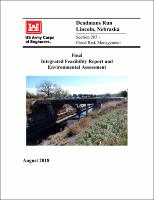Please use this identifier to cite or link to this item:
https://hdl.handle.net/11681/48254| Title: | Deadmans Run, Lincoln, Nebraska: Section 205 - Flood Risk Management : Final Integrated Feasibility Report and Environmental Assessment |
| Authors: | United States. Army. Corps of Engineers. Omaha District |
| Keywords: | Lincoln (Neb.) Flood control Environmental management Environmental protection |
| Publisher: | United States. Army. Corps of Engineers. Omaha District. |
| Abstract: | This flood risk management study is being carried out under the authority of Section 205 of the 1948 Flood Control Act, (P.L. 80-858), as amended. Under Section 205, the Corps is authorized to study and construct projects (structural and/or nonstructural) to reduce the risks of flooding, loss of life, and property damage in partnership with state and local governments. The non-federal sponsor for this study is the Lower Platte South Natural Resources District (LPSNRD) in Lincoln, Nebraska. In April of 2012 the LPSNRD submitted a request for the U.S. Army Corps of Engineers (Corps or USACE) – Omaha District to analyze potential solutions to reduce flood risks within the city of Lincoln. This study is needed to address the significant flood risk within the almost completely urbanized Deadmans Run watershed in Northeast Lincoln, Nebraska. The purpose of this study was to: 1) quantify the flood risks and related flood problems associated with the Deadmans Run watershed within Lincoln, Nebraska, 2) formulate and evaluate alternative plans to address those flood threats, 3) compare those plans against one another based on costs, benefits, and impacts, and 4) select a recommended plan for implementation that would reduce the existing flood risk within the community. Historical urbanization and development has led to an increased flood risk within the city of Lincoln. The primary problems associated with the existing flood risk within the study area are potential life loss, property damage, emergency response costs, and transportation network disruptions associated with high-water flood events. The Expected Annual Damages (EAD) associated with these problems, within the study area, under the existing conditions are just under $2.0M. Flood risk management measures were developed collaboratively with input from the city of Lincoln, LPSNRD, other local and state resource agencies, and the Corps. The solutions investigated included structural measures (levees, channels, etc.), nonstructural measures (floodproofing, relocations, etc.), and a combination of both structural and nonstructural measures. Over a dozen flood risk management measures were identified and screened before being developed into alternatives. A total of four alternatives, including No Action, were evaluated and compared, and based on economic benefits and costs a preferred plan was selected and recommended for implementation. The selected plan for the Section 205 Flood Risk Reduction Feasibility Study, includes a widened channel from Cornhusker Highway upstream to just east of 48th Street (approximately 1.4 miles), replacement of the existing concrete mat and gabions with riprap sized to mitigate streambed erosion and construction of a concrete flume under the BNSF Railroad bridges. This recommended plan consists of increasing the channel capacity to convey the flows associated with the 1% Annual Chance Exceedance (ACE) event, constructing a concrete flume under the existing railroad structures, reconfiguring the access road and underlying culvert to a series of commercial properties along the bank of the channel, and environmental mitigation throughout the project footprint to ensure there is no negative impact on the existing local ecosystem. The recommended flood risk management plan has an estimated total project cost of just over $14.2M. The recommended plan, as developed in this feasibility study and updated in Section 4.4, will reduce flood risks for 487 structures in the Deadmans Run 1% ACE floodplain. This plan would reduce the EAD from $1,946,800 to $520,810 (a 73.0% reduction), resulting in economic benefits of $1,425,990. After accounting for the annualized project costs, the annual net benefits for the recommended plan are $895,610, producing a project benefit to cost ratio (BCR) of 2.69. The estimated cost-shared total for project implementation is $14,235.000. Of the total cost, $1,726,000 is for land, easements, rights-of-way, relocation, and disposal costs (LERRDs), for which credit will be given to the sponsor. Of the total cost, the federal portion is approximately $9,253,000 and the non-federal portion is approximately $4,982,000. Of the total non-federal portion, approximately $3,256,000 will be provided in cash and $1,726,000 will be provided in LERRDs. Estimated average annual cost for operations, maintenance, repair, replacement, and rehabilitation is $25,010. |
| Description: | Integrated Feasibility Report and Environmental Assessment |
| Rights: | Approved for Public Release; Distribution is Unlimited |
| URI: | https://hdl.handle.net/11681/48254 |
| Appears in Collections: | Environmental Documents |
Files in This Item:
| File | Description | Size | Format | |
|---|---|---|---|---|
| Deadmans Run Section 205 - Integrated FR and EA_2018.pdf | 207.21 MB | Adobe PDF |  View/Open |